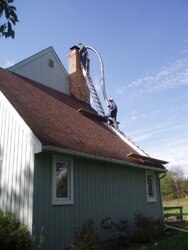As soon as the weather allows, I will be installing the liner for my Fireview. I've got a 30-ft run, and I have to wrap it with the .5 inch insulation and metal cladding. Then I have to get it up onto my roof and somehow negotiate it down into the chimney.
Any tips before I proceed? With all that wrapping, I can't imagine you'd want to bend it too much, but raising 30 feet of it strait up in the air might be a challenge too, especially if there's any wind.
I will also need to put an S-curve in the bottom 5 feet or so in order to have it come out of the damper in the centered location. That will have to be done after I get it down the chimney, but I won't be able to reach up there with my hands.
I could really use some guidance from someone with experience. The stuff bends, but with a considerable amount of effort.
Oh, one other thing: does the liner need to be cleaned before applying the spray adhesive for the insulation. Is the adhesive really necessary? The manual seems to indicate that it's optional.
Any tips before I proceed? With all that wrapping, I can't imagine you'd want to bend it too much, but raising 30 feet of it strait up in the air might be a challenge too, especially if there's any wind.
I will also need to put an S-curve in the bottom 5 feet or so in order to have it come out of the damper in the centered location. That will have to be done after I get it down the chimney, but I won't be able to reach up there with my hands.
I could really use some guidance from someone with experience. The stuff bends, but with a considerable amount of effort.
Oh, one other thing: does the liner need to be cleaned before applying the spray adhesive for the insulation. Is the adhesive really necessary? The manual seems to indicate that it's optional.


